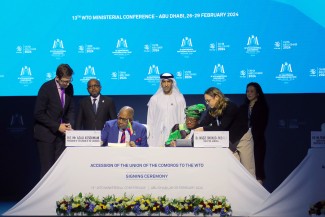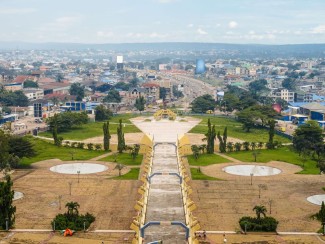Originally published in World Economic Forum Agenda.
- Digitalized supply chains can address sustainability concerns in the least developed countries (LDCs).
- Technologies like AI, blockchain, and IoT can improve efficiency and reduce waste, but it's crucial to ensure these technologies benefit the LDCs.
- We examine successful initiatives in countries like Bhutan, Bangladesh, Cambodia, Ethiopia, Nepal, Rwanda, Timor-Leste and Vanuatu.
Digitalization has the potential to transform the way businesses achieve a triple bottom line – economic, social and environmental – to address the rising concerns of shareholders. One way to achieve this objective is to enhance transparency and meaningful integration of these dimensions into the entire supply chain, for which digitalization can be a powerful tool.
A study on the Impact of Digitalization of Sustainable Supply Chains shows the prospects of various digitally powered technologies, such as artificial intelligence (AI), additive manufacturing, blockchain, big data and the Internet of Things (IoT), all of which can contribute to supply chain sustainability.
While there is little doubt that the digitalization of supply chains helps reduce inventory, waste and the environmental footprint, saves time and cut costs, digitalization does not help almost two-thirds of the population of the least developed countries (LDCs) that are still offline. Therefore, the inclusion of the excluded (offline population) is equally, if not more important, if the past development paradigm of "winner takes all" is to be avoided.
Digitalized supply chains have the potential to address sustainability concerns from the perspective of the LDCs. Real-life examples demonstrate how small steps taken in LDCs in the digitalization of trade facilitation and business processes and efforts aimed at enhancing supply chain transparency are benefiting small businesses and farmers.
Paperless trade facilitation
Digitalization of border trade procedures and moving towards paperless trade is a promising mechanism to make trade and supply chains not only climate-friendly but also inclusive. For example, the United Nations Economic and Social Commission for Asia and the Pacific (ESCAP) estimates that fully digitalizing regulatory procedures around trade could save between 32kgs and 86kgs of CO2 equivalents per end-to-end transaction. Extrapolating these to Asia and the Pacific region where the study was conducted, this implies potential savings of 13 million tons of CO2, equivalent to planting 439 million trees.
A practical example of this can be found in Vanuatu, a country that recently graduated from LDC status, where the Electronic Single Window project digitalized procedures for the issuance of bio‑security security certificates. As a result, the government managed to reduce the time taken for the issuance of bio-security certificates from six days to 10 minutes and thus achieved a 95% reduction in paperwork and a 86% reduction in physical trips required for the certification processes. These reforms contributed to cutting down CO2 emissions by 5,827kgs.
Likewise, the introduction of an Electronic Single Window in Timor-Leste resulted in a 90% decrease in physical trips between government agencies and an 80% cut in printed customs documents. Due to this reform, Timor-Leste has lowered its CO2 emissions by 14,492 kgs.
In Cambodia, the Universal Postal Union, the United Nations Conference on Trade and Development, the Global Alliance for Trade Facilitation and Swisscontact have worked together to support an Electronic Advanced Data interface between customs and postal services with a view to ensuring the speedy completion of e-commerce (trade in parcels) transactions for micro-, small- and medium-sized enterprises.
Digitalizing business processes
Business process digitalization can contribute to higher efficiency and productivity and enable flexible and customized production processes, thereby contributing to sustainability. Digitalization not only supports different blocks of the sustainable business model but also offers a potential virtuous, reinforcing cycle between digitalization and sustainability.
One practical example of business process digitalization is found in Bhutan, where the ambitious "e-infrastructure for trade and services" project implemented by the Food Corporation of Bhutan (FCB) supported the transition towards a digital ecosystem. The project helped install machine grading and an electronic auction system for potatoes in the southern town of Phuntsholing, which contributed to increased price transparency, a reduced cartelization and a decrease in transaction costs.
Moreover, the initiative has resulted in lower waiting times and faster payments (from four days to four hours) and savings of $420 per truckload of potato auctioned for farmers. Impressed by these results, the FCB has replicated this model by establishing a new centre in Wangdue Phodrang district at the heart of one of the largest potato-producing region in July this year.
In Bangladesh, the Enhanced Integrated Framework supported the establishment of the Centre of Innovation, Efficiency and Occupation Safety and Health Improvement (CEOSH) on the premises of the Bangladesh Garment Exporters and Manufacturers Association to train owners, managers and workers on latest technologies, such as AI, blockchains and 3D printing, with a view to reducing production and trade costs and complying with environmental and social norms. CEOSH also acts as a clearing house for the latest knowledge, information and trends on fashion market and supply chain practices. The project came handy in the context of Bangladesh's impending graduation from the LDC category, which may result in extensive preference erosion.
Supply chain transparency
Digital technologies have become an important tool to enhance supply chain transparency to allow retailers and consumers to trace the various stages of a supply chain from the origin of the products to the store shelves. This is even more important for issuing organic certification to the products, as demonstrated by examples from various LDCs.
Although still at a relatively incipient stage, the Ethiopia Traceability Project pilots a traceability system with three wet mills in the Sidama region, where most of the coffee is sourced from thousands of smallholder farmers as well as local coffee collectors/buyers. The project's anticipated benefits include improved and digitalized traceability; increased trust between producers and buyers; and the increase of organic certifications.
In Nepal, the use of digital technology to enhance traceability of the orthodox tea value chain has enabled farmers to obtain organic certification, fetch better prices for their products and diversify their exports. As a result of the intervention, the export price of tea has increased from $8 per kg to $9.5 per kg.
In Rwanda, a pilot project uses blockchain technology and digitalized traceability systems to support women coffee farmers, since this commodity is a key driver of economic growth, stability and improved income for over 450,000 farmers. As the country’s leading export crop, it has contributed an average of 24% to total agricultural exports over the last decade.
While digitalization and sustainability paradigms are moving in tandem, offering tremendous prospects to make our planet fairer and more liveable, concerted efforts are required to make it more inclusive. The examples provided above demonstrate that small initiatives can deliver tangible results. If they can be plugged into much larger initiatives such Digital Trade for Africa and scaled up and replicated, where possible, they can make a transformative impact.
If you would like to reuse any material published here, please let us know by sending an email to EIF Communications: eifcommunications@wto.org.


